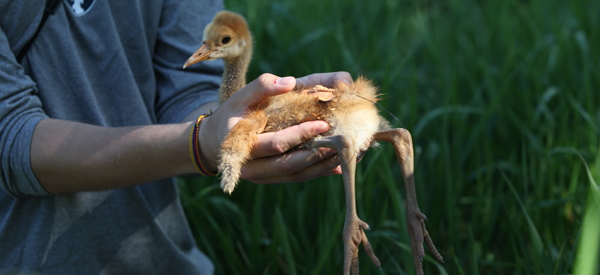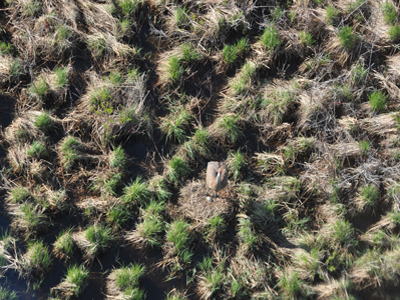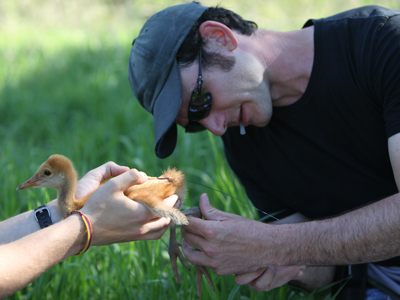 A small radio transmitter is gently attached to a Sandhill Crane chick in central Wisconsin.
A small radio transmitter is gently attached to a Sandhill Crane chick in central Wisconsin.
The transmitter, designed to fall off as the chick grows, will provide valuable information on
the movements of the chick and its parents during the summer. Photo by Ted Thousand
Since 1990, ICF has banded over 400 Sandhill Cranes in central Wisconsin, one of the densest nesting populations of cranes known anywhere in the world (we annually track around 60 breeding territories in our 6,400 ha study area). The small leg bands and radio transmitters, the latter placed on a select number of cranes, allow our staff to identify and track individual birds – once we can identify individuals, we can follow their movements, form hypotheses about their behaviors, and test these ideas in the field.
 In April, ICF staff participated in a helicopter survey of Sandhill Crane nests in central Wisconsin (right, photo by Andy Gossens). We coordinated the survey with University of Illinois graduate student, Jeff Fox, who is comparing Sandhill Crane breeding in rural areas with suburban areas near Chicago. ICF’s research, which in part focuses on how local crane breeding density changes over time, and what effects breeding density might have on reproductive success and survival, will help Jeff forecast future changes in suburban cranes as these populations grow over time. These are important factors to consider, as both people and cranes move closer into each other’s territories (whether it is a rural farm field near a wetland or a backyard in suburban Chicago).
In April, ICF staff participated in a helicopter survey of Sandhill Crane nests in central Wisconsin (right, photo by Andy Gossens). We coordinated the survey with University of Illinois graduate student, Jeff Fox, who is comparing Sandhill Crane breeding in rural areas with suburban areas near Chicago. ICF’s research, which in part focuses on how local crane breeding density changes over time, and what effects breeding density might have on reproductive success and survival, will help Jeff forecast future changes in suburban cranes as these populations grow over time. These are important factors to consider, as both people and cranes move closer into each other’s territories (whether it is a rural farm field near a wetland or a backyard in suburban Chicago).
 Following the helicopter survey, Jeff and ICF staff have identified four Sandhill Crane families with chicks suitable for our research. The chicks are captured and fitted with small radio transmitters (right, Jeff takes a blood sample from a chick, which will be used to determine the gender of the young crane. Photo by Ted Thousand).
Following the helicopter survey, Jeff and ICF staff have identified four Sandhill Crane families with chicks suitable for our research. The chicks are captured and fitted with small radio transmitters (right, Jeff takes a blood sample from a chick, which will be used to determine the gender of the young crane. Photo by Ted Thousand).
